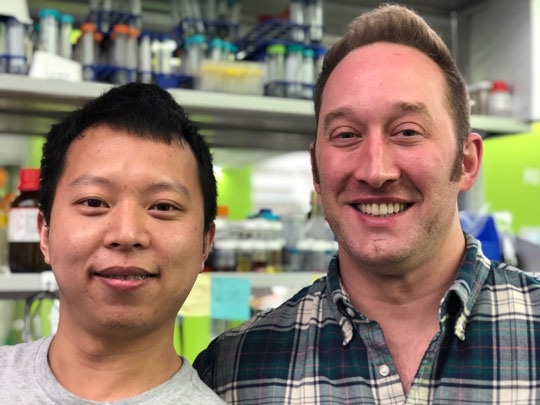Reviewed by Alex SmithJul 26 2022
Rice University scientists have discovered that tetrahedron-shaped nanoparticles do something remarkable.
 Zhihua Cheng (left) and Matthew Jones. Image Credit: Rice University.
Zhihua Cheng (left) and Matthew Jones. Image Credit: Rice University.
While performing a regular check on a batch of tiny gold tetrahedrons, Rice chemist Matthew Jones and graduate student Zhihua Cheng discovered that their microscopic particles had the unexpected potential to align themselves into 2D chiral superstructures.
The breakthrough, which is elaborated in a new study in the journal Nature Communications, is probably the first-known concurrent self-assembly of a planar chiral structure, stated Jones.
Chiral structures are known as mirror opposites, similar forms, like right and left hands, that cannot be superimposed onto one another. It is a significant distinction in drug design, where chiral molecules could be therapeutic on the one hand and poisonous on the other.
Tetrahedrons themselves do not appear to be chiral—that is, they could be superimposed on their mirror images. That made it twice as surprising that they fell in such a simple manner into chiral forms at the time of the experiments while being evaporated onto a surface, stated Jones.
This is unexpected. It’s very rare to see a chiral structure form when your building blocks are not chiral.
Matthew Jones, Chemist, Rice University
Jones stated that the 2D superlattices created by the tetrahedra could result in progress in metamaterials that manipulate light and sound in beneficial ways.
There’s a whole series of papers that predict some of the most interesting properties from optical metamaterials arise in structures that have chirality at this length scale.
Matthew Jones, Chemist, Rice University
The chiral surfaces made at Rice are known as ultrathin assemblies of particles that integrate left-handed and right-handed domains in equal numbers. That matters in how they process circularly polarized light is a beneficial tool in plasmonics and spectroscopy.
Jones stated that one method to construct accurate 2D structures is to start with a big piece of material and work from the top down, like a sculptor. This eliminates undesirable bits to arrive at the preferred shape.
Self-assembly is known as a bottom-up method where a large structure, similar to a tree, grows from the linking of innumerable small pieces. Normally, bottom-up assembly is the quicker and more effective of the two methods.
Most of the time people use spherical particles in self-assembly, but you just can’t get that much complexity in terms of the structure. My group takes non-spherical particles and tries to get them to assemble themselves into more sophisticated structures.
Matthew Jones, Chemist, Rice University
Since an approach to making well-formed gold nano-tetrahedrons has been discovered, Jones and Cheng put them in a solution and positioned a droplet on a substrate.
Jones stated, “We just let the droplet evaporate, and what we get out are these amazing superlattices. There are two things that make them amazing. One is that they’re exclusively two-dimensional, and the second, which is more interesting, is that they’re chiral.”
Initially, Jones and Cheng thought the particles could grow in three dimensions, “but we now understand how they form such a complicated 2D structure that is two particles thick,” stated Jones.
Cheng added, “Initially we didn’t expect them to assemble at all. I just wanted to see that the particles were pure and uniform in size. When I saw the different chiral arrangements it was a total surprise to me that they assembled into such a cool structure!”
Jones stated that the particles benefit from various phenomena as they assemble, such as van der Waals forces, electrostatic repulsion between the molecules on the tetrahedron surfaces, and the substrate the droplet is built on.
Jones added, “Over time, as the droplet evaporates, the particles go from mostly repulsive to strongly attractive, and that’s how they crystallize into superlattices.”
The hexagonal domains of the material form when the tetrahedrons come together with their tips. As the particles assemble, their points meet, requiring them to slide past each other a bit to continue getting closer together.
This drives all the particles in the assembling hexagon to rotate one way or the other, thereby developing left- and right-handed chiral domains.
Jones observed that there is a mathematical foundation to the phenomenon that someone might eventually figure out.
“It was only recently that the densest packing of spheres was mathematically proven, so it may be some time before we can expect something similar for tetrahedra. It’s very, very complicated,” added Cheng
Jones said he sees the possibility of one day “assembling a material like this at the surface of a swimming pool” so that sophisticated metamaterial coatings could be employed on virtually any object just by dipping it in the liquid surface.
Jones is the Gene and Norman Hackerman Junior Chair, the Norman Hackerman-Welch Young Investigator, and an assistant professor of chemistry and materials science and nanoengineering.
This study was financially supported by the Robert A. Welch Foundation (C-1954), the David and Lucile Packard Foundation (2018-680049), and Rice University.
Achiral to chiral
Video Credit: Rice University.
Journal Reference:
Cheng, Z. & Jones, M. R. (2022) Assembly of planar chiral superlattices from achiral building blocks. Nature Communications. doi.org/10.1038/s41467-022-31868-2.